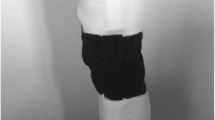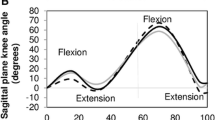Abstract
Purpose
There are questions concerning the influence of computer-assisted surgery and the minimal invasive surgical technique on the outcome of total knee arthroplasty. The authors followed up the rehabilitation of patients during the first postoperative year.
Methods
The ZEBRIS gait analysis system was used to obtain numerical data of kinetic and kinematic gait parameters. There were three groups of patients: patients operated by the conventional technique (Group I), patients operated on using computer-assisted surgery (Group II), and patients who underwent the surgical procedure by a minimally invasive technique and computer-assisted surgery (Group III). Both groups consisted of 15 patients. Gait analysis was performed preoperatively and 3, 6, 9, and 12 months after the surgery. The range of motion of the pelvis, the hip and the knee, the step width and the stride length were measured during walking.
Results
Results were compared with the parameters measured in a group of healthy subjects of the same age (control group). The value of the measured parameters in Group I and in Group II reached the value of the control group 6 months after surgery. In Group III, this occurred 3 months after surgery.
Conclusions
The results of the study confirm that navigation does not influence the length of rehabilitation. However, in case of minimal invasive surgery, rehabilitation is faster than in Groups I and II.

Similar content being viewed by others
References
Alton F, Baldey L, Caplan S, Morrissey MC (1988) A kinematic comparison of over ground and treadmill walking. Clin Biomech 13:434–440
Bejek Z, Paróczai R, Illyés Á, Kiss RM (2006) The influence of walking speed on gait parameters in healthy people and in patients with osteoarthritis. Knee Surg Sports Traumatol Arthrosc 14:612–622
Bejek Z, Solyom L, Szendroi M (2007) Experiences with computer navigated total knee arthroplasty. Int Orthop 31:617–622
Börjesson M, Weidenhielm L, Atsson E, Olsson E (2005) Gait and clinical measurements in patients with knee osteoarthritis after surgery: prospective 5-year follow-up study. Knee 12:121–127
Dalury DF, Dennis DA (2005) Mini-incision total knee arthroplasty can increase risk of component malalignment. Clin Orthop Relat Res 440:77–81
Frigo C, Bardare M, Corona F, Casnaghi D, Cimaz R, Naj Fivono PL (1996) Gait alterations in patients with juvenile chronic arthritis: a computerized analysis. J Orthop Rheumatol 9:82–90
Grood ES, Suntay WJ (1983) A joint coordinate system for the clinical description of three-dimensional motions. Application to the knee. J Biomech Eng 105:136–144
Kellgren JH, Lawrence JS (1957) Radiological assessment of osteoarthritis. Ann Rheum Dis 16:494–502
Kiss RM (2007) Verification of determining the spatial position of the lower extremity by ultrasound-based motion analyser. Periodica Politechnica Ser Civ Eng 51:39–43
Kiss RM, Kocsis L, Knoll Z (2004) Joint kinematics and spatial temporal parameters of gait measured by an ultrasound based system. Med Eng Phys 26:611–620
Knoll Z, Kocsis L, Kiss RM (2004) Gait patterns before and after anterior cruciate ligament reconstruction. Knee Surg Sports Traumatol Arthrosc 12:7–13
Laskin RS, Beksac B, Phongjunakorn A, Pittors K, Davis J, Shim JC, Pavlov H, Petersen M (2004) Minimally invasive total knee replacement through a mini-midvastus incision: an outcome study. Clin Orthop Relat Res 428:74–81
Lombardi AV Jr, Viacava AJ, Berend KR (2006) Rapid recovery protocols and minimally invasive surgery help achieve high knee flexion. Clin Orthop Relat Res 452:117–122
Matsas A, Taylor N, McBurney H (2000) Knee joint kinematics from familiarized treadmill walking can be generalized to over ground walking in young unimpaired subjects. Gait Posture 11:46–53
McCrory JL, White SC, Lifeso RM (2001) Vertical ground reaction forces: objective measures of gait following hip arthroplasty. Gait Posture 14:104–109
Möckel G, Perka C, Labs K, Duda G (2003) The influence of walking speed on kinetic and kinematic parameters in patients with osteoarthritis of the hip using force-instrumented treadmill and standardized gait speeds. Arch Orthop Trauma Surg 123:278–282
Rasch A, Dalén N, Berg HE (2010) Muscle strength, gait, and balance in 20 patients with hip osteoarthritis followed for 2 years after THA. Acta Orthop 81:183–188
Sparmann M, Wolke B, Czupalla H, Banzer D, Zink A (2003) Positioning of total knee arthroplasty with and without navigation support: a prospective, randomized study. J Bone Surg (Br) 85-B:830–835
Tria AJ Jr, Coon TM (2003) Minimal incision total knee arthroplasty: early experience: early experience. Clin Orthop Relat Res 416:185–190
Victor J, Hoste D (2004) Image-based computer-assisted total knee arthroplasty leads to lower variability in coronal alignment. Clin Orthop Relat Res 428:131–139
Wang H, Dugan E, Frame J, Rolston L (2009) Gait analysis after bi-compartmental knee replacement. Clin Biomech 24:751–754
Acknowledgments
This work was supported in part by the Hungarian Scientific Fund T049471.
Author information
Authors and Affiliations
Corresponding author
Rights and permissions
About this article
Cite this article
Bejek, Z., Paróczai, R., Szendrői, M. et al. Gait analysis following TKA: comparison of conventional technique, computer-assisted navigation and minimally invasive technique combined with computer-assisted navigation. Knee Surg Sports Traumatol Arthrosc 19, 285–291 (2011). https://doi.org/10.1007/s00167-010-1219-9
Received:
Accepted:
Published:
Issue Date:
DOI: https://doi.org/10.1007/s00167-010-1219-9




